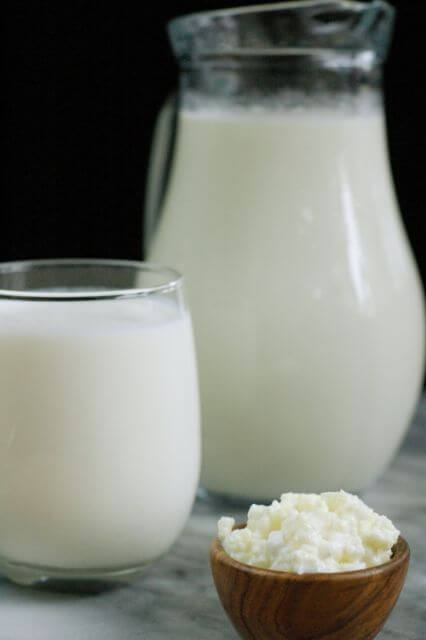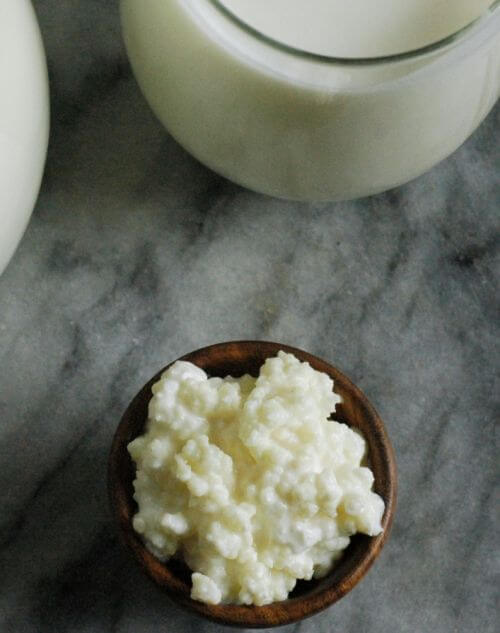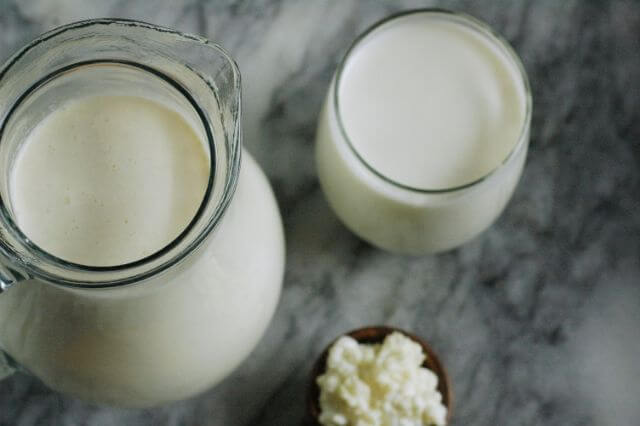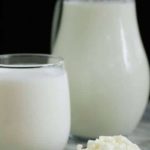Making kefir at home is easy, fast and super fun! Homemade kefir made from kefir grains also contains more beneficial bacteria and probiotics than most store bought and is cheaper too!

Friends. We really haven’t ever talked about my obsessive love of Kefir? This is craziness, how have we made it over 2 years on this blog and not talked about this?
The #1 thing I recommend to people when I introduce them to the world of fermentation and healthy eating is that they learn how to make kefir at home. It is so easy to do that even folks who have super busy lives can easily fit it into their schedule.
Kefir is a probiotic rich cultured dairy product that is slightly thinner and more tangy than most yogurt. It is considered by many to be a super food and for some people helps in regulating digestion, boosting the immune system, alleviating symptoms of allergies, yeast infections (thrush), constipation, irritable bowel syndrome and many other things. And potentially most important…it tastes delicious!
We drink it plain like a yogurt drink or use it as the base for our green smoothies.
I have gifted dozens of batches of kefir grains to friends and family over the last few years and have answered a lot of emails and text messages about their new “kefir babies”. I’ve done my best to catalog the most frequent questions I have run into and will continue to update it as needed. I hope you will find this useful and that you will start making kefir at home!
How Do I Make Kefir Grains?
In a short answer….you can’t. Kefir is like the ultimate friendship bread! It has survived for more than 2,000 years by being passed from family to family. As of this writing, the only way to source kefir grains is to be gifted them from someone who already cultivates them, find them on Craigslist, or purchase them from a reputable source online like Cultures for Health.
Where Do They Come From?
There are various reports on the origins of Kefir grains, most revolving around the nomadic sheep herders of the North Caucasus Mountains. They were a closely guarded family secret and passed with great care from generation to generation. It wasn’t until the early 1900’s that the grains were available to anyone outside of this select group of families. A fascinating story worth reading is retold in various places on the internet about the procuring of the first grains for commercial production in Russia by the beautiful Irina Sakharova.
One strain of research seems to believe that the grains came about after milk was exposed to some kind of sheep intenstinal flora….which could have come about by someone using a sheep stomach as a bag for holding milk. This seems to make sense from the idea that the grains originated from sheepherders. However attempts to recreate this scenario and many many others have never produced viable kefir grains. They are a true mystery!

What exactly are Kefir grains? Are They Real Grains?
Kefir grains are not real grains but are called that simply based on their appearance. They are technically a SCOBY which stands for Symbiotic Colony Of Bacteria & Yeast. They are a live complex combination of organisms that coexist in perfect harmony. Absolutely amazing!
What are the Benefits of Kefir?
Kefir is considered by many to be a super food. And I can tell you from personal experience when we are drinking it regularly we feel better, catch far fewer colds, and have a more regulated…ehm….bathroom regiment? According to Lindsey over at HomemadeMommy:
“Kefir made from live kefir grains has 35 different strains of beneficial bacteria and yeasts. Kefir isn’t at all like yogurt in that kefir actually colonizes our digestive tracts with this beneficial bacteria and yeast. Yogurt and many other so called probiotic foods on the market today actually only provide prebiotics or simply – they provide food for the good bacteria that live in the intestinal tract. Laboratory grown yogurt has only 1 or maybe as high as 5 strains of beneficial bacteria and laboratory grown kefir for manufactured products has only 10 strains.”
It is also still an integral part of the diet of the people of the Causcaus Mountains which boast a ridiculously impressive lifespan and healthy population (article here).
“In a further breakdown of official figures, one out of every 300 Abkhazians is 100 years old or over. For comparison, note that in the U.S. only 3 in 100,000 reach 100 years of age. “
Yes please!
Can I Drink Kefir If I Am Lactose Intolerant?
Maybe! If you have a lactose intolerance problem it is highly likely you will be able to tolerate homemade kefir. The kefir grains consume the majority of the lactose in the milk in the fermentation process, making it often a great option for people with lactose intolerance. You may find that you are only able to tolerate kefir made from raw milk versus pasteurized/homogenized milk too, several of my non-dairy friends have experimented with this with good success.
Studies have shown that Kefir can actually help to improve the entire digestive system including aiding in healing a lactose intolerance problem. Store bought kefir does not include the same level of probiotics and is often thickened after processing with powdered non-fat milk so it is likely not to be tolerated as well or at all.
Are there Non-Dairy Kefir options?
Yes! You can make non-dairy kefir (coconut kefir, rice milk kefir, etc) at home too, but eventually your grains will die if they are cultured exclusively in non-mammalian “milk”. To help this you can put them in a batch of regular milk every 2 weeks or so and let them go through a 24 hour process. Then rinse them with your preferred alternative milk.

Ok I’m Sold…How Do We Take Care of Them?
**We are assuming you are starting with viable live grains that you received in person in milk. If you get dried grains refer to your instructions that come with them to rehydrate them**
How to Make Kefir
Ingredients
- kefir grains
- milk
Instructions
- 1. Place kefir grains in glass jar (1 pint- 1 quart size) and fill up the jar with the appropriate level of milk. You are looking to give them a ration of 1 part kefir grains to 7 parts milk. If you have a tablespoon or two of grains start with a pint jar, if you have a 1/4 cup or more you should be fine in a quart size jar. Never store in metal containers or leave metal utensils in the container long term.
- 2. Cover top loosely with a clean towel or paper towel. Secure with a rubberband or use the ring of a mason jar if you are using one. I like using a cloth that covers the entire jar, I feel that a darker environment is more beneficial for the kefir and more in line with the traditional completely enclosed sheep skin bag. You want to prevent any flies/bugs from contaminating it but not have an airtight seal. As it ferments it will release CO₂ and will become fizzy and build pressure in jar if you use a lid with an airtight seal.
3. Place out of direct sunlight or in cabinet for 12-48 hours.
4. Strain every 12-48 hours based on taste preference. A stainless steel or plastic strainer is safe to use for straining.
Notes
Ways To Alter The Taste or Texture of Kefir:
The flavor of Kefir can be drastically changed by several things…
Taste:
The longer you ferment the more sour it will be.
Texture:
The kefir will splits into two separate parts…Kefir and whey. When this happens the the Kefir itself will be thicker but if you stir the whey back into the kefir it actually becomes thinner than if you process it before it splits.
For the thickest consistency allow the kefir to split and strain off the whey. You can also strain it in cheesecloth to thicken it further.
Carbonation:
If you want to experiment with a more fizzy drink you can use an airtight lid during fermentation. Be sure to leave more head room and monitor it closely. I have never heard of an exploding milk kefir fermentation but explosions can happen in a water kefir fermentation and it is not a pretty thing.
Try it different ways to find the perfect kefir for you!
Help! It’s Processing Too Fast/Too Slow?
The grains will process the milk faster in warm weather, slower in cool weather.If it is taking longer than 48 hours to separate, strain it anyways and then add less milk the next time. If it processes super fast you can add more milk next time or just realize it will be more sour at that milk level.
Help! I Have Too Many Grains!
Your grains will multiply….rapidly in the warm weather. If you get too many and are going through too much milk, share them with friends, eat them if you like, freeze some in case your kefir dies or feed them to your animals.
I’m Going On Vacation….Do I Need A Kefir-Sitter?
If you are going on vacation you can place them in the fridge for up to a week or two with fresh milk before you leave. I will often give the 2x the normal amount of milk. Strain as soon as you get home. Try not to use this too often as it throws them out of their groove a bit. The first few batches may taste a little funny as they get back into their routine but should be safe to drink. Use good sense: if it smells wonky, don’t drink it.
Should I Rinse My Kefir Grains?
No! I never recommend rinsing your kefir grains with anything but fresh milk. Tap water can actually kill your kefir grains and even filtered or distilled water does not help them do anything but get out of balance in my opinion. I have done it both ways. If something happens to your grains that you feel they need to be rinsed (fall in the sink, something falls in them etc) you can rinse them with milk. Under normal circumstances though, they do not ever need to be rinsed.
Why Are My Kefir Grains Are Yellow?
If your grains start to yellow on the outside and feel hard to the touch then the exterior is dead or dying. This is most often caused from not changing the milk frequently enough or keeping them in the fridge too often. If they are just a little yellow try changing the milk and give them a few batches (if these smell/taste off do not drink them).
If this does not revive them you must remove the dead exterior of the grain and hope that you find white grain underneath. Rub them back and forth in your fingers to remove the exterior. If you do find white healthy grains underneath you should be able to save them, if not you will need to start fresh with new grains. (This is a great reason to store backup grains in your freezer!)
If you use raw milk or very high fat content milk this can also cause a yellowing effect but they should continue to produce a good product.
Other Questions? Ideas? Share them in the comments!


Loved your video!
Can I use goats milk? We have Nigerian dwarf goats high butterfat content milk
Yes Julia! Goat’s milk works amazing!
I love my kefir!!! So much that I can occasionally be found talking to them-thanking them for changing milk into something this lactose intolerant mama can consume!!!
Thank you so much! I am so excited to try this! How will I know if it smells or tastes funny? Does it taste like yogurt?
Hi Kate!
It should smell sweet and tangy or slightly cheese like (or really cheesy if you forgot it a few days haha). It is thinner than yogurt and more tangy. Sign up for our Kefir Challenge here and get our free ebook on it!
theadventurebite.kinsta.cloud/free-30-day-kefir-challenge/
i just love love kéfir products, think it is an aquired taste but one you get it, you just do not get tired of it 🙂
THAT was simply AMAZING !!!! Wonderfully written post , and awesome video…thank you for all the new information !!!
I learned so much from your post! I had no idea “kefir grains” existed! Thank You!
You are welcome! I love these little guys so it’s great fun sharing them with folks 🙂
Thanks for this tutorial; Have never heard of Kefir. Now to find some…
Awesome! That’s so exciting to me that there are people who are still discovering it. I love it so much!